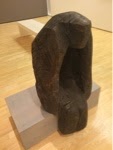Samoća - solitude; loneliness
Samostan - monastery
Samovoljan - self willed; obstinate
In a Split art gallery yesterday there was an incredibly evocative wooden sculpture called 'Sam IV' (1972) by Branko Ružić. It was in dark old wood, a trunk hollowed out to resemble a seated figure, hunched against the world. His back, shoulders, and head are rounded, hands seemingly tucked under his thighs. The effect of Ružić's simple, empathic carving is on the surface utterly bleak. If a friend or loved one was to sit like this, you'd think their world had fallen in.




